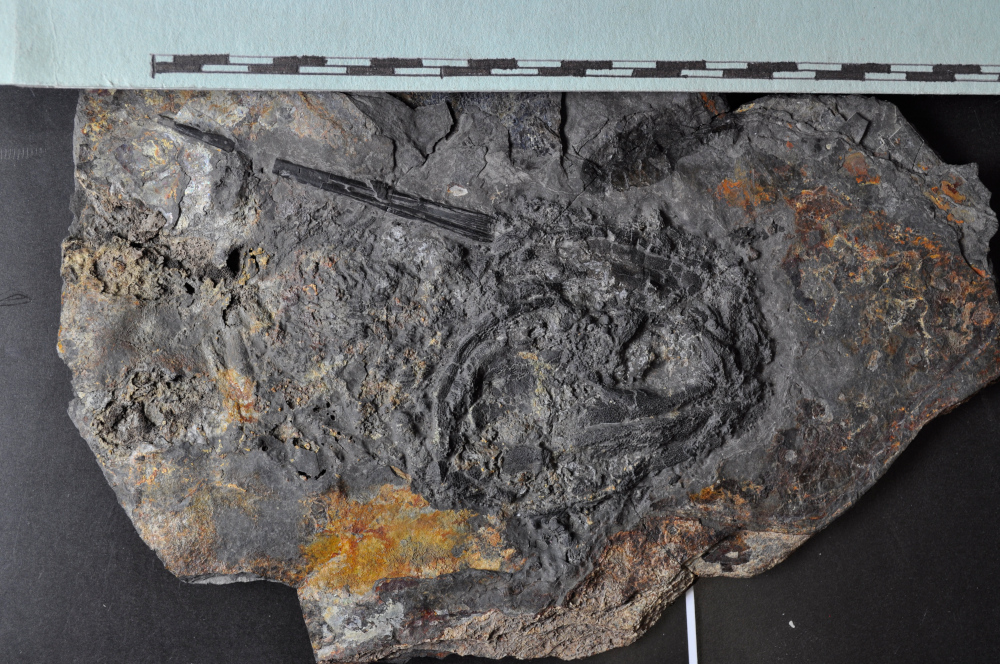Triodus aeduorum
Luccisano, Pradel, Amiot, Gand, Steyer & Cuny, 2021
Classification: Elasmobranchii Xenacanthiformes Xenacanthidae
Reference of the original description
A new Triodus shark species (Xenacanthidae, Xenacanthiformes) from the lowermost Permian of France and its paleobiogeographic implications. Journal of Vertebrate Paleontology, 41(2), Article e1926470
A new Triodus shark species (Xenacanthidae, Xenacanthiformes) from the lowermost Permian of France and its paleobiogeographic implications. Journal of Vertebrate Paleontology, 41(2), Article e1926470
Types
Triodus aeduorum
Holotype: MHNA: PAL-2020-0001; Paratype: MHNA: PAL-2020-0002; MHNA: PAL-2020-0003;
Triodus aeduorum
Holotype: MHNA: PAL-2020-0001; Paratype: MHNA: PAL-2020-0002; MHNA: PAL-2020-0003;
Description:
Citation: Triodus aeduorum Luccisano, Pradel, Amiot, Gand, Steyer & Cuny, 2021: In: Database of fossil elasmobranch teeth www.shark-references.com, World Wide Web electronic publication, Version 01/2026
Please send your images of "Triodus aeduorum" to info@shark-references.com

Triodus aeduorum Luccisano, Pradel, Amiot, Gand, Steyer & Cuny, 2021, paratype, MHNA-PAL-2020-0002 from the Muse OSB © Gilles Cuny

Triodus aeduorum Luccisano, Pradel, Amiot, Gand, Steyer & Cuny, 2021, paratype, MHNA-PAL-2020-0002 from the Muse OSB © Gilles Cuny
Distribution Geographic
Excavation site of Muse (Path of the Poil Fou/Les Echars), Dracy-Saint-Loup Municipality, Saône-et-Loire, France
Excavation site of Muse (Path of the Poil Fou/Les Echars), Dracy-Saint-Loup Municipality, Saône-et-Loire, France
Distribution Stratigraphy
Horizon—Bottom of the Fish layer, Muse OSB, Muse formation, Autun Basin, Northern Massif Central, lowermost Asselian, Cisuralian, Permian
Horizon—Bottom of the Fish layer, Muse OSB, Muse formation, Autun Basin, Northern Massif Central, lowermost Asselian, Cisuralian, Permian
Description
Original diagnosis after Luccisano et al. 2021 [29809]: Triodus species is defined by the following combination of characters. For the teeth: a maximum height of 2 mm, a rounded to rhomboid base, median cusps between one-half and two-thirds the size of the lateral ones, three to five vertical cristae on the labial side and one or none vertical crista on the lingual side of the cusps, few irregular bifurcation patterns, rounded cross-section of the cusps that becomes polygonal toward the apex, angle of 110–130° between the crown and the base in mesial or distal view, rounded to oval coronal button always with a lingual shaft; up to eight oral nutrient foramina and up to 11 basal nutrient foramina and median cusps not labially displaced. For the dorsal spine: dorso-ventrally compressed with lateral hook-shaped denticles, wide proximal ventral groove that almost reaches the apex, numerous fine proximal longitudinal striations and a width/length ratio of 1/13.
Original diagnosis after Luccisano et al. 2021 [29809]: Triodus species is defined by the following combination of characters. For the teeth: a maximum height of 2 mm, a rounded to rhomboid base, median cusps between one-half and two-thirds the size of the lateral ones, three to five vertical cristae on the labial side and one or none vertical crista on the lingual side of the cusps, few irregular bifurcation patterns, rounded cross-section of the cusps that becomes polygonal toward the apex, angle of 110–130° between the crown and the base in mesial or distal view, rounded to oval coronal button always with a lingual shaft; up to eight oral nutrient foramina and up to 11 basal nutrient foramina and median cusps not labially displaced. For the dorsal spine: dorso-ventrally compressed with lateral hook-shaped denticles, wide proximal ventral groove that almost reaches the apex, numerous fine proximal longitudinal striations and a width/length ratio of 1/13.
References

A new Triodus shark species (Xenacanthidae, Xenacanthiformes) from the lowermost Permian of France and its paleobiogeographic implications. Journal of Vertebrate Paleontology, 41(2), Article e1926470
DOI: 10.1080/02724634.2021.1926470

A new Triodus shark species (Xenacanthidae, Xenacanthiformes) from the lowermost Permian of France and its paleobiogeographic implications. Journal of Vertebrate Paleontology, 41(2), Article e1926470
DOI: 10.1080/02724634.2021.1926470

















